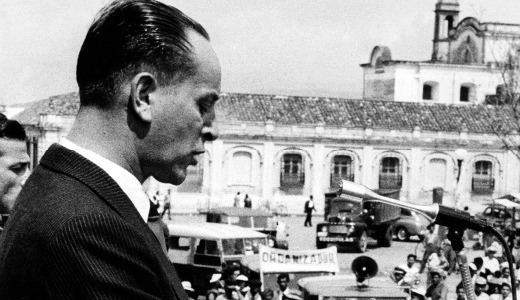
The Captaincy General of Guatemala along with the rest of New Spain achieved independence in 1821. For the first twenty years after independence, Guatemala serves as the capital of the new Central American Federation but the union quickly dissolves by 1841 with the emergence of today’s overall geographic demarcations. For the next one hundred years, the country’s history is marked by continued subordination of indigenous communities, and the prevalence of undemocratic authoritarian rule.
|
1931 |
The only candidate in the elections, Jorge Ubico wins and becomes increasingly dictatorial during his presidency, refusing to leave the post. In his later years, his regime becomes stagnant, leading to a general strike which forces his retirement. |
|
|
1931 – 1944 |
Jorge Ubico |
Dictator. Deposed. |
|
1941 – 1945 |
Guatemala joins the Second World War as an ally of the USA and Great Britain on 9 December 1941, against Japan, Germany and Italy. In 1944, for planning to violate the constitution of El Salvador by declaring a third term of office without holding elections, President Hernandez is forced to deal harshly with the Palm Sunday Coup. Soon afterwards, in May, he is deposed anyway during the ‘Strike of Fallen Arms’. Students lead the passive movement against him which paralyses the country by encouraging everyone to remain at home. It soon escalates into a general strike. The movement spreads to neighbouring Guatemala, where another military dictator, Jorge Ubico, is removed from office. Ubico is still able to install General Juan Federico Ponce as his successor. |
|
|
1944 |
Juan Federico Ponce Vaides |
Dictator. Overthrown. |
|
1944 – 1945 |
Ponce is deposed during a coup and the country is temporarily governed by a military junta. Guatemala’s first free elections are held the same year to find a new president. Juan Jose Arevalo takes office in 1945. Arevalo was a fervent Guatemalan nationalist and led the push for social reforms including the establishment of a social security system, and a stronger emphasis on labor rights. “Arevalo sought to restrain the U.S. companies that dominated Guatemala’s economy and his tentative attempts to enforce the country’s 1947 labor code on the plantations of the United Fruit Company, were deemed ‘persecution'” (Gleijeses 133). |
|
| 1950-1954 | Jacobo Arbenz Gutierrez elected president in free elections | “Inaugurated in 1951, Arbenz presided over the most successful agrarian reform in the history of Central America.” The reports of the US embassy bear testimony to the fact that within eighteen months land was distributed to 100,000 peasant families, amid little violence and without adversely affecting production” (Gleijeses).
Arbenz never declared himself a communist, but it is important to note that “he could not have [passed the agrarian reform alone]. Praise must be given to the Communist Party of Guatemala, whose leaders were Arbenz’s closest personal and political friends” (Gleijeses). |
|
1954 |
Arbenz is overthrown in the first US-backed coup in Latin America, bringing an end to “ten years of spring,” and democracy in the country. | |
1954 US-Backed Coup
The 1954 Guatemalan coup was in direct response to Arbenz’s ambitious agrarian reform. “Threatened” by the “communist” government of Jacobo Arbenz, the United Fruit Company did everything in its power to influence the United States’ foreign policy and approach to Arbenz’s reforms. The success of the 1954 coup marked the start of a pattern of US-backed coups throughout the region and a new era of violence and impunity in the country.
La Gloriosa Victoria
_______________________________________________
Related Readings:
How America overthrew Guatemala’s reformist president
The Guatemalan Revolution and Civil Rights: Presidential Elections and the Judicial Process under Juan José Arévalo and Jacobo Arbenz Guzmán
June 27, 1954: Elected Guatemalan Leader Overthrown in CIA-Backed Coup
GUATEMALA: Battle of the Backyard
________________________________________________________________________
Sources:
Espionart. “Rivera Paints the Guatemalan Coup d’État.” ESPIONART, 21 June 2014, espionart.com/2014/06/20/rivera-paints-the-guatemalan-coup-detat.
Kessler, P. “American Colonies – Guatemala.” The History Files, www.historyfiles.co.uk/KingListsAmericas/CentralGuatemala.htm#Federal%20Republic. Accessed 3 May 2022.

